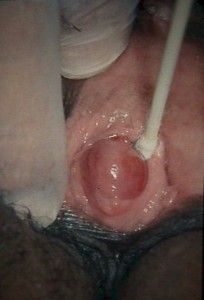A Skene’s gland is on each side of the urethral opening.
It is normally neither seen nor felt, although close inspection will reveal the pinpoint openings of these periurethral glands.

When infected, the Skene’s gland will become enlarged and tender.
A simple incision and drainage of the gland will generally result in complete resolution. Topical anesthetic (20% benzocaine, or “Hurricaine”) can be applied to the cyst with a cotton-tipped applicator and allowed to sit for 3-4 minutes. A single stab wound by a scalpel opens the abscess and allows for drainage of the pus.
Cultures, particularly for gonorrhea, should be obtained.
Whenever gonococcal infection is suspected or confirmed, good choices for antibiotics would include those most helpful for treating urethritis due to gonorrheal infection:
Uncomplicated Gonococcal Infections of the Cervix, Urethra, and Rectum*
Recommended Regimen
- Ceftriaxone 250 mg IM in a single dose
PLUS - Azithromycin 1g orally in a single dose
Alternative Regimens
If ceftriaxone is not available:
- Cefixime 400 mg orally in a single dose
PLUS - Azithromycin 1 g orally in a single dose
In the event gonorrhea cannot be confirmed, then treatment following non-gonorrheal urethritis (NGU) should be considered:
Treatment*
Recommended Regimens
- Azithromycin 1 g orally in a single dose
OR - Doxycycline 100 mg orally twice a day for 7 days
Alternative Regimens
- Erythromycin base 500 mg orally four times a day for 7 days
OR - Erythromycin ethylsuccinate 800 mg orally four times a day for 7 days
OR - Levofloxacin 500 mg orally once daily for 7 days
OR - Ofloxacin 300 mg orally twice a day for 7 days
As a directly observed treatment, single-dose regimens might be associated with higher rates of compliance over other regimens. To maximize compliance with recommended therapies, medications should be dispensed onsite in the clinic, and regardless of the number of doses involved in the regimen, the first should be directly observed.
*CDC 2015 STD Treatment Guidelines
